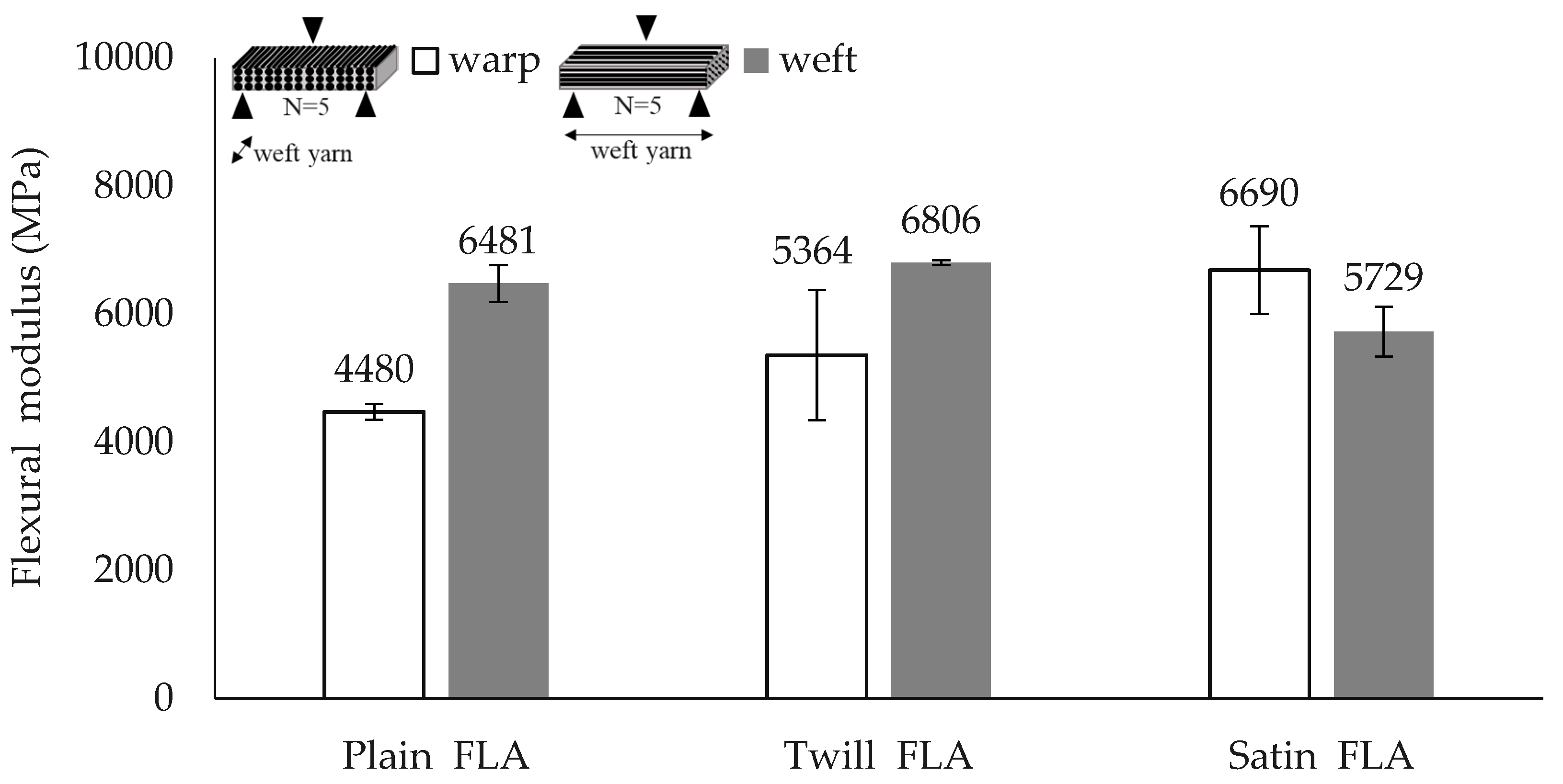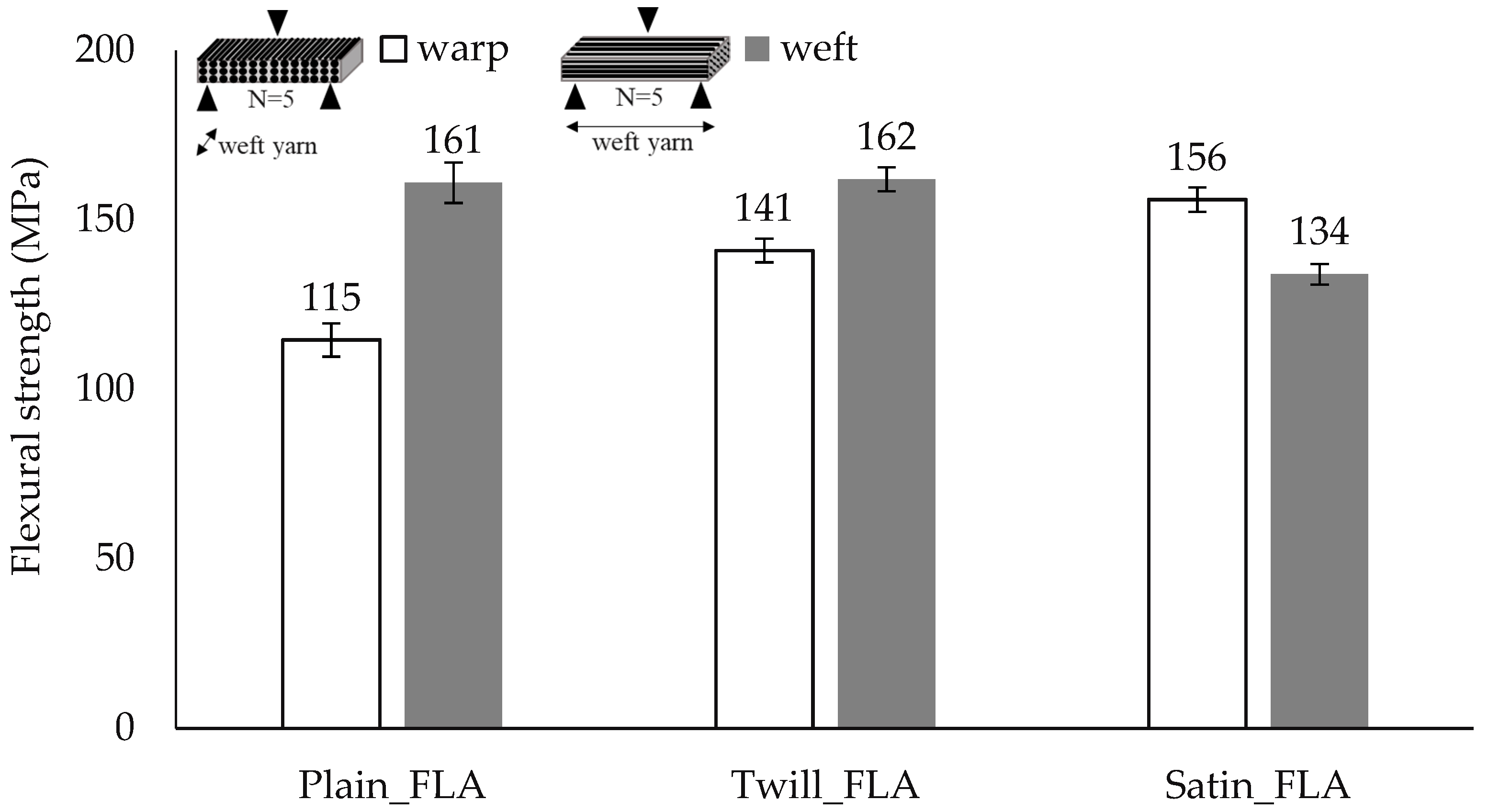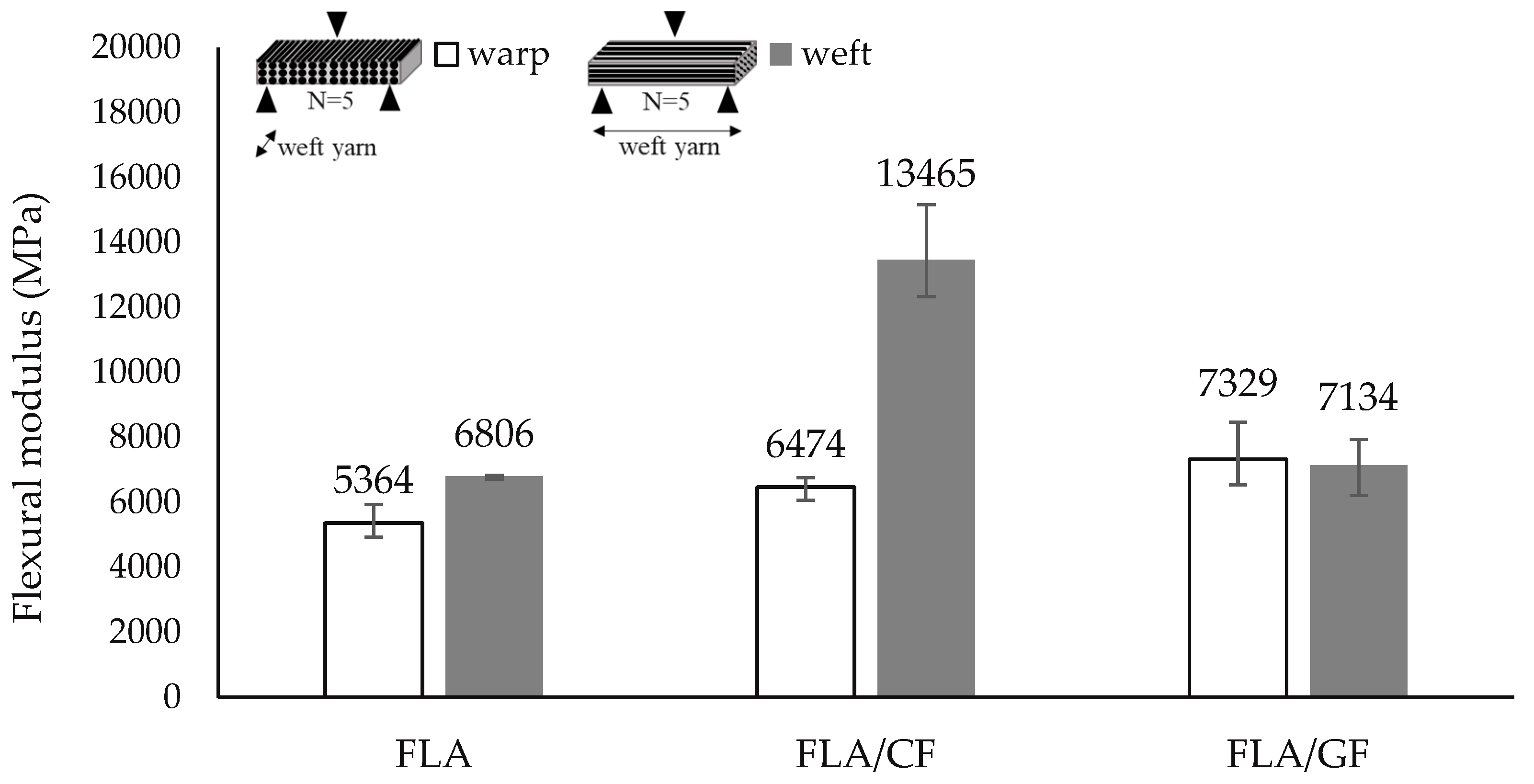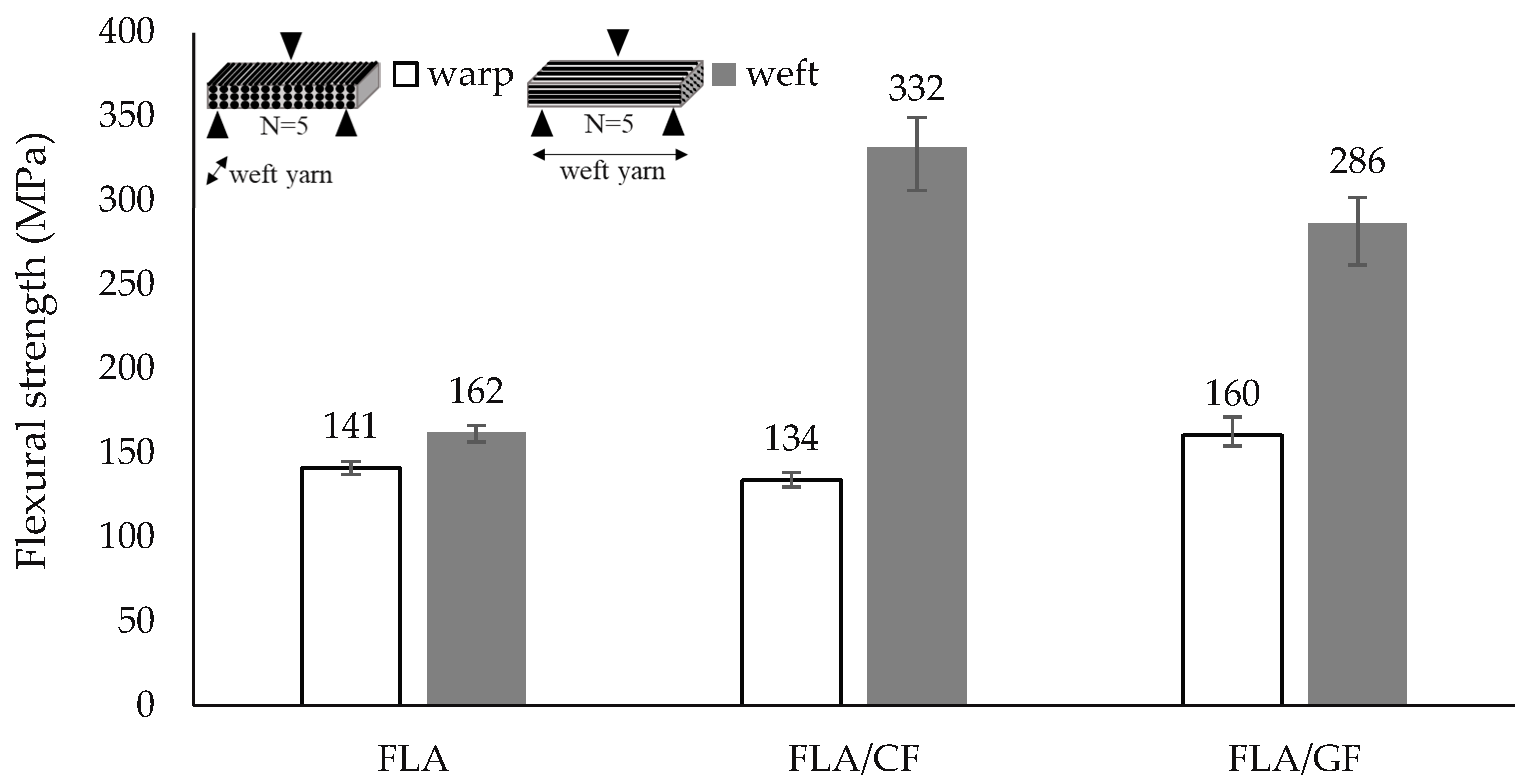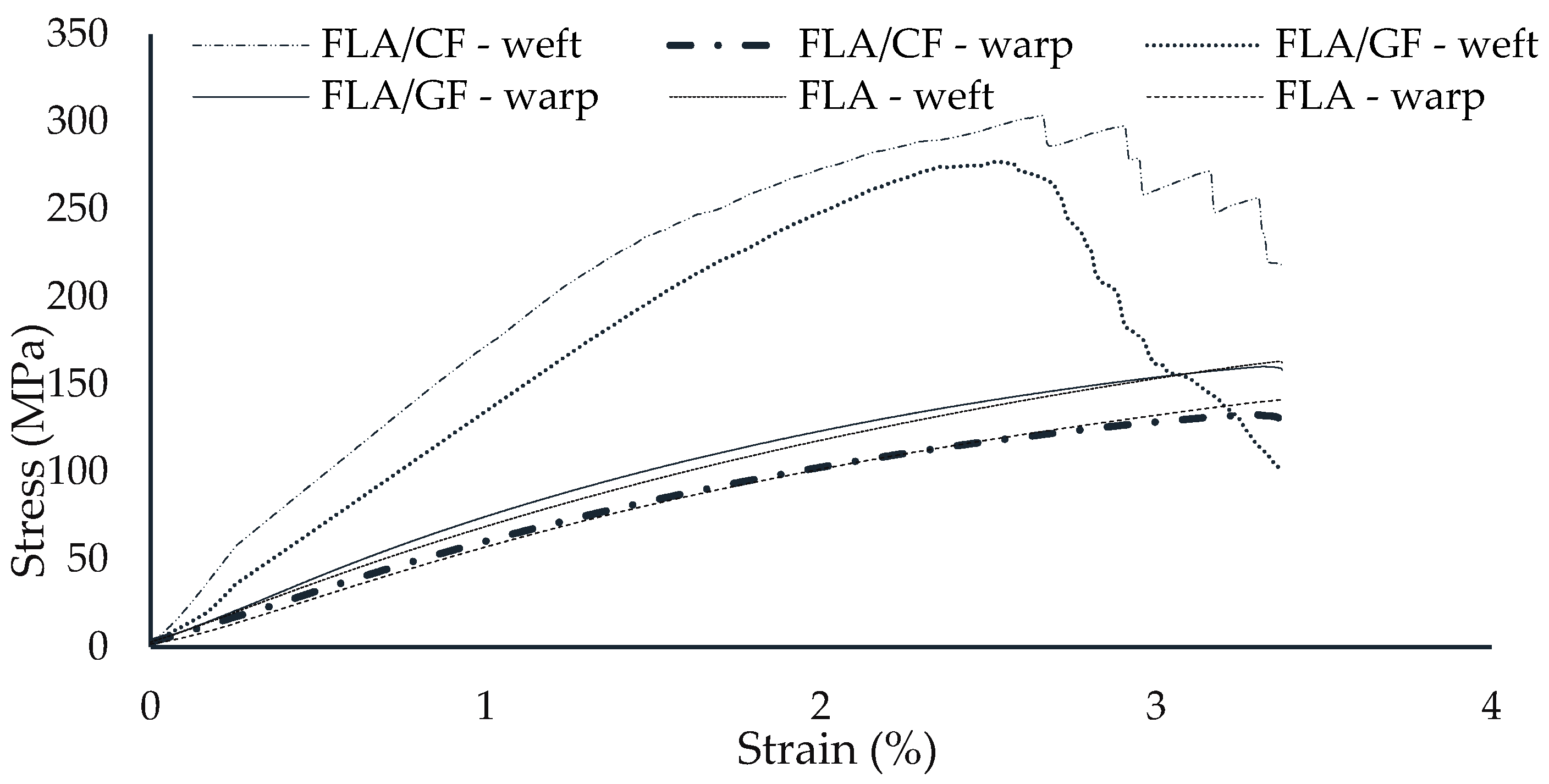1. Introduction
Due to growing environmental awareness, various industry sectors already use or attempt to use materials based on renewable resources in their production. In this context, numerous lightweight application sectors, like automotive or sport and leisure, have already validated the beneficial use of biobased composites containing natural fibers [
1,
2]. In comparison with synthetic fiber composites, natural fiber composites offer potentially more effective recycling possibilities, mainly due to their biobased feedstock and the possibility to generate an additional energy output in the case of incineration. Both life cycle-analysis of numerous natural fiber composites and various recycling approaches are described in literature [
3]. Besides the ecological advantages that natural fibers like flax or hemp offer in comparison with synthetic high-performance fibers like glass or carbon, natural fibers also offer numerous technical benefits, like low density [
4,
5] or good sound and vibration damping properties [
6]. The dynamically growing use of natural fibers in composite applications has been extensively described in literature [
1,
2,
7,
8]. Currently, natural fibers are mainly used as a single type of reinforcement in one composite. Several studies reported successful use of a mixture of two or more natural fiber types in one composite [
9] or a mixture of natural fibers with glass fibers in injection molding [
10,
11], a sheet molding compound process [
12] or as textile composites [
11]. The main advantage of the hybridization of natural and synthetic fibers is the possibility to produce biobased composites with a significantly enhanced mechanical performance. Nevertheless, it is important to consider that despite the biobased feedstock of natural fibers, currently there are no satisfactory solutions for the recycling of hybrid composites consisting of natural and synthetic fibers.
However, in the case of hybrid textile biocomposites, the reported approaches concentrate on the use of sandwich structures, where the natural fiber mats are sandwiched between synthetic fiber mats, like e.g., Palmyra fibers sandwiched between glass fiber mats [
11,
13] or flax fiber plies sandwiched between carbon plies [
14]. This approach is represented schematically in
Figure 1.
Although this approach offers a simple manufacture of biobased hybrid composites with significantly improved mechanical properties, it is not possible to adjust the mechanical isotropy of the resulting composite material. Consequently, hybridization of natural and synthetic fibers directly in one textile would enable the manufacture of tailored biobased hybrid composites with isotropic mechanical properties. Therefore, the approach of this study represents an alternative solution for the manufacture of hybrid natural/synthetic fiber composites. Instead of stacking the textiles in a certain sequence to sandwiches, the new approach combines synthetic and natural fibers using a weaving technique directly in one textile. The aim of this study is to manufacture hybrid woven textiles containing flax fibers as a warp yarn and carbon fibers or glass fibers as a weft yarn and to evaluate the flexural properties of the resulting hybrid biocomposites as a function of yarn direction and compared with the flax biocomposites.
Woven textiles for composite applications: Woven textile composites containing a polymer matrix and a textile reinforcement provide an attractive solution for industry, since they are easy to handle and enable simple manufacturing of flat construction parts. The woven textiles for composite applications are available in various weave patterns. The basic weave pattern types used in this study, namely, plain, twill, and satin, are represented in
Figure 2.
The selected pattern has a significant effect on the properties of the manufactured textile and the corresponding composite material. Mass per area of textile and crimp of the yarns in the textile are among the most important properties affected by the weave pattern. The mass per area (or textile density) depends on the number of yarns required to realize a certain pattern. The crimp refers to the relation of the length of a strip of the woven textile and the length of the yarn, used to weave this textile [
15,
16]. Lower crimp means that the yarns in a woven textile are more stretched and the corresponding composites possess higher mechanical properties, e.g., satin compared with plain weave. At the same time, the textile composites with tighter crimp, e.g., plain weave, offer higher structural elongation than the corresponding composites with twill or satin weave [
15]. The crimp of warp and weft yarns affect one another, and the desired balance can be adjusted using the settings of the corresponding weaving machine. It is important to consider, that in composites, the crimp is also responsible for weak points, because adequate wetting of fibers by matrix beneath the crossover points of the weft and warp yarns is challenging [
17]. Furthermore, since the yarns are not straightened in the textile, the polymer matrix permeability is further inhibited. An overview of the advantages of the basic patterns at identical warp and weft density and identical yarn material for composite applications is presented in
Table 1 [
15].
In the cases where the number of warp and weft yarns per cm, i.e., yarn count, and the corresponding spacing between the yarns is equivalent, the fabric is called “balanced woven fabric”. The balanced woven fabrics result in uniform tensile properties in both longitudinal and transverse directions [
18]. Variation of the yarn counts can be used as an approach to adjust the isotropy of mechanical properties. Another possibility to optimize the mechanical performance of textile composites is to use at least two different yarn materials in one woven fabric. This method results in a so called “hybrid textile”. In the last few years, high potential of the hybrid textiles made of synthetic fibers for composite applications gained the attention of industry and researchers. Numerous studies reported advantageous mechanical performance of these hybrid composites, e.g., aramid-/glass fabric polyester [
19], glass-/aramid and glass-/polyethylene fabric epoxy [
20]. An extensive review of the hybrid composites with glass, carbon and aramid fibers hybridized at different levels from ply to yarn level is described in literature [
21].
However, the approaches for the manufacture of biobased hybrid woven textiles containing natural and synthetic fibers for composite applications are hardly known. Consequently, this feasibility study aims to demonstrate, that the manufacture of the twill-weaved biobased hybrid textiles for composite manufacture offers not only ecological benefits but also application-oriented advantages regarding bending properties.
3. Results and Discussion
In the following section, the manufactured composites are characterized according to their physical and mechanical properties.
3.1. Density
The generally used approach to determine the density of the fiber composites containing only synthetic fibers is based on volume fractions of the composite constituents with known densities [
26]. Furthermore, the information regarding density of the composite components and the corresponding volume fractions can be effectively used for the estimation and evaluation of the void content and the mechanical performance of the synthetic fiber composites. However, in contrast with the synthetic fibers, the measurement of the density of natural fibers is challenging due to the geometry of these fibers and the presence of lumen. Moreover, according to literature, the measured density of flax depends on the measuring method and the origin of the fibers [
27,
28]. As an example, the density of the same flax measured via weighing in air and in a liquid (Archimedes’ principle) and using a helium pycnometer differs by up to 12% [
28]. Besides the measuring method, factors like origin and retting process as well as the moisture content affect the density of the flax fibers. Consequently, the density values of flax available in literature vary from 1.0 g/cm
3 [
5] to 1.57 g/cm
3 [
22].
Therefore, in this study the density of the produced composites is measured experimentally using the buoyancy method based on Archimedes’ principle. One drawback of this method is that the liquid can enter the porosity network of the composites through the surface-connected pores [
5]. Consequently, the results presented in this study merely demonstrate a relative comparison. In order to analyze the void content, the cross-sections of the composites are examined.
The density values of the flax and the hybrid composites are represented in
Table 4, respectively. In the case of flax composites, it is observed that all of the composites possess nearly the same density. These results show a good correlation with the literature values of flax fiber-reinforced epoxy composites manufactured via vacuum infusion [
25], namely, 1.28 g/cm
3 and 1.26 g/cm
3. Two explanations are possible for this behavior. Firstly, it is possible that the density of flax and epoxy resin is very similar, and therefore change in mass fractions is not reflected in the overall composite density. Secondly, since the density is the ratio of mass to volume, the comparable density values show that the mass and the volume of the composite specimens increase proportionally. However, the proportional increase of the ratio can be induced by different sources, because the wetting degree of textiles has not been analyzed yet. In the latter case, the slightly lower mean value of the flax composite with twill weaved textile can be induced by higher void content. Furthermore, the density value of this composite compared with the density values of other two composites has higher deviation, showing the inhomogeneity of the composite. In the next step, the density values of flax composites are correlated with the fiber mass fraction and images of the cross-sections of the specimens.
A clear density difference is observed in the case of the hybrid composites. Namely, the density of the flax-/carbon composite is 5% and density of the flax-/glass composite is 13% higher than that of the flax biocomposite. It is important to consider that except the specimen thickness, other parameters of the hybrid composites, like e.g., the areal weight of the hybrid textiles, the absolute mass of the hybrid composites as well as the mass fractions of flax and synthetic fiber yarns are same (
Table 3). Consequently, this difference in density is definitely induced by the smaller volume of the hybrid composites, i.e., the thickness of the flax-/glass composite (5.89 mm) is lower in comparison with the thickness of the flax-/carbon composite (6.44 mm). The mass fraction of synthetic fibers in flax-/carbon and in flax-/glass composites is same, namely, 50%. The density difference can be further increased by void content or material-specific properties of synthetic fibers, which promote or inhibit their compatibility with flax fibers, like e.g., sizing, rigidity, etc.
To sum up, differences in fiber volume of the synthetic fibers used for the manufacture of hybrid textiles, void content and possibly differences in sizing or rigidity of glass and carbon fibers may lead to the differing density values. Therefore, similarly, as in the case of the flax composites, the determination of the fiber mass content in the composites and optical examination of the cross-section are conducted in order to better understand this behavior.
3.2. Fiber Mass Fraction
The values of the specimen thickness, span length, absolute mass of the composite, and fiber mass fraction are summarized in
Table 5. The results show that both weave pattern and used yarn type have a significant influence on the fiber mass fraction in the biocomposites and the thickness of the specimens. As already mentioned above, both areal weight as well as the height of the resulting composites are dependent on the number of yarns employed in the realization of a certain pattern.
In this study, the number of warp counts used for the manufacture of plain, twill, and satin patterned flax textiles is 60 T/10 cm, 130 T/10 cm and 145 T/10 cm, respectively (
Table 3). According to the results, the thickness of the flax composites shows good correlation with the areal weight of the textiles presented in
Table 3 and the absolute composite mass presented in
Table 5. The lowest height belongs to the composite with plain weaved fabric, namely, 5.10 mm (322 g/cm
2 and 580 g), followed by twill 6.53 mm (483 g/cm
2 and 832 g) and satin 7.36 mm (488 g/cm
2 and 839 g). The information about the specimen thickness is important for the testing and it plays a significant role in a product manufacturing, since it affects the wall thickness of the construction part. Furthermore, the change in the thickness of the specimens leads to the change in volume and thus, possibly, the density of the specimens. During vacuum infusion process, only one metal mold is used and the thickness of the resulting specimen depends significantly on the textile type and the areal weight.
Regarding the fiber mass fraction, the flax composite with satin weave results in the highest fiber mass fraction (41%), followed by the composite with plain weaved textile (37%) and twill weaved textile (35%), respectively. General comparison with other studies on other natural fiber composites shows that these fiber mass fractions are reasonable. As an example, manually manufactured plain, twill and satin weaved kenaf textiles integrated into unsaturated polyester resin via vacuum infusion result in mass fractions of 37.9%, 40.0% and 38.0%, respectively [
29]. A further example is a unidirectional (UD) and multidirectional (MD) flax fiber-reinforced epoxy composite manufactured using vacuum infusion [
25]. In this case, based on the mass fraction of the flax and its density taken as 1.540 g/cm
3, the authors report the fiber volume fractions. Recalculation of the reported fiber volume fractions to the fiber mass fraction results in 44.5% for UD composite and 37.9% for MD composite, respectively.
Comparison of the fiber mass fractions of the plain, twill and satin patterned flax composites shows that the highest fiber mass fraction (41%) is achieved in the case of the satin textile with the highest areal weight (488 g/m2). This leads to the assumption that the satin weave including the largest number of fiber yarns may have the lowest epoxy resin permeability and fiber wetting. The mass fraction of flax fibers in the composites with plain and twill weaves is comparable, namely, 37% and 35%, although the number of the used yarns and the areal weight of the plain and twill fabrics differ significantly.
In the case of the hybrid textile composites, the height of the flax-/glass composite is 9% lower than that of the flax-/carbon composite. At the same time, both of the composites have the same overall fiber mass fraction (47%). Hence, the lower thickness and correspondingly lower volume of the flax-/glass composite is induced by the difference of the glass fiber density in comparison with the carbon fiber density. As such the same mass of glass fibers possesses lower volume results in a thinner composite.
3.3. Digital Microscope Images
Depending on the manufacturing method and matrix type, there are several types of voids, which may be present in composite materials [
5]. Particularly, large cavities can be induced by gross defects during manufacturing and small voids adjacent to fibers can be caused by incomplete infiltration. There are two commonly used approaches for the determination of the void content: examination of a composite cross-section or measurement of the composite density [
5]. Both of these methods have advantages and disadvantages during application on natural fiber composites. Namely, examination of the cross-section provides information about the distribution and a relative size of the voids. However, during the sample preparation, such as during polishing, the fiber fragments may be lost. Furthermore, this approach represents void content merely in the analyzed specimen area. Consequently, if the voids are not homogeneously distributed within the specimen, the results of the analysis can be misrepresentative. During the measurement of the density using Archimedes’ principle, this problem is avoided. However, in order to use this approach for the evaluation of void content, the density values of all constituents have to be determined. As already mentioned above, an accurate measurement of flax density is challenging. Thus, in the scope of this study the relative void content in the composites is determined qualitatively combining the results of the both methods.
The digital microscope images of the composite cross-sections are represented in
Figure 5. These images show clearly that the composites include different void content. Particularly, the flax composite with plain weaved textile, which contains the lowest number of yarns (
Table 3) and has the lowest thickness shows nearly no voids. On the other hand, the flax composite with twill weaved textile has many large voids. The flax composite containing satin weaved fabric includes also some voids, but these voids are significantly smaller, than in the case of the composite with the twill weaved textile. At the same time, both of the latter composites contain a comparable number of yarns (
Table 3). Furthermore, the comparison of the images representing the cross-sections of the twill and satin weaved flax composites shows that, the voids are present at the points where the weft and warp yarns are crossing each other, hence representing bad infiltration [
5]. The presence of these large voids explains the lower density value of the flax composite with twill patterned textile and its high deviation. However, it does not explain the lower fiber mass fraction of the twill patterned flax composite in comparison with the flax containing plain patterned textile.
In the case of hybrid textiles, the void content in the composite with flax-/carbon textile is significantly higher than in the case of the composite with flax-/glass textile. This behavior further explains the lower density of the flax-/carbon composite in comparison with the flax-/glass composite. Thus, showing that there are mainly two factors leading to the lower density of the flax-/carbon composite, namely, lower volume of the glass fibers required to reach the mass fraction of 50% and the higher void content in flax-/carbon composite.
Regarding the source of the voids in hybrid composites, as mentioned above, there are two major reasons: manufacturing defects or incomplete infiltration. Since all of the composites are manufactured using the same technique and no visual defects are notified during or after the fabrication, most probably the higher void content in flax-/carbon composite is induced by the incomplete infiltration. One of the possible explanations could be better compatibility of glass and flax fibers than that of carbon and flax fibers. This can be induced by the chemistry of the glass fiber surface. Both of these fibers are polar due to the hydrophilic nature caused by the presence of hydroxyl groups on the fiber surface. Furthermore, the sizing of the glass fibers can promote the compatibility. As an example, silane-based coupling agents, which are commonly used in order to improve fiber-matrix-adhesion in glass fiber composites are also effectively used for the same aim in natural fiber composites [
30]. On the other hand, the inert surface of carbon fibers is firstly oxidized and afterwards coated with a polymer finish, promoting fiber-matrix-adhesion [
31]. Commonly, this polymer coating is adjusted for a special matrix type. Consequently, this may inhibit the compatibility between carbon and flax fibers. However, in order to prove this assumption, a separate study focused on the compatibility of synthetic and natural fibers should be conducted.
3.4. Flexural Properties of Flax Composites
Due to the modification of the span length, the achieved results represent merely a relative comparison of the flexural properties of the composites. According to literature, the span length significantly affects the results of the synthetic fiber-reinforced composites. As an example, the values of flexural strength and modulus of a unidirectional glass fiber-reinforced thermoset polymer analyzed with a span length varied from 10 mm to 20 mm, result in 540 MP and 9.7 GPa and 792 MPa and 20.3 GPa, respectively [
32]. Whether the varied span length affects the flexural properties of natural fiber composites and hybrid textile composites as significantly as in the case of the synthetic fiber composites has not been studied yet. However, it is important to consider that under accurate adjustment of the span length according to testing standard, the mean values of the composite properties can vary.
The flexural modulus values of the flax composites are presented in
Figure 6. The composites with plain and twill weaves show similar tendency regarding isotropy, i.e., the modulus in the weft direction is higher than that in the warp direction. The composite with satin patterned fabric shows an inverse behavior. In the warp direction, the composite with the satin weave shows the highest result (6690 MPa). This is followed by the composite with the twill patterned fabric (5364 MPa) and the composite with plain weave has the lowest modulus (4480 MPa). This tendency is expected based on the overview described in
Table 1 and is induced by the increasing number of yarn counts, namely 60, 130 and 145 T/10 cm for plain, twill and satin, respectively (
Table 3).
In the weft direction, the mean value of the composite with twill weaved fabric is the highest, followed by slightly lower modulus of the composite with plain patterned textile and the composite with satin weave has the lowest value. Correlation of these data with the fiber mass fraction represented in
Table 5, shows that the decrease of the flexural modulus in weft direction is inversely proportional to the decrease of the fiber mass fraction of the biocomposites. Namely, twill fabric composite with 6806 MPa and 35%, plain fabric composite with 6481 MPa and 37% and twill fabric composite with 5729 MPa and 41%.
The flexural strength of the flax composites is represented in
Figure 7. Similarly, as in the case of the flexural modulus, the strength of composites with plain and twill weaved fabrics in weft direction is higher than in warp direction. The composite with the satin weaved fabric shows an inverse trend and its strength in warp direction is 16% higher than in the weft direction. In the warp direction, the composite with plain weaved fabric shows the lowest strength (115 MPa) and the composite with the satin weaved fabric shows the highest strength (156 MPa). Consequently, the flexural strength of the composite with twill weaved fabric in warp direction is 23% higher than that of the composite with plain weaved fabric. These results are in agreement with the increasing number of yarns in this direction (
Table 3).
In the weft direction, the strength of the composites with plain and twill patterned fabrics is nearly equal, 161 MPa for plain and 162 MPa for twill, respectively. The strength of the composite with satin patterned fabric is approximately 17% lower. This tendency shows that the strength is not related to the number of yarns in weft direction (90 T/10 cm). However, similarly as in the case of flexural modulus, this tendency is inversely proportional to the fiber mass fraction. At the same time, the fact that the plain weaved textile reinforcement leads to a nearly the same strength as the twill weaved textile makes it more advantageous for application. The plain weaved textile has a significantly lower areal weight than twill fabric and results in a lighter and thinner composite. The areal weight of plain fabric is 322 g/cm
2 and of twill 483 g/cm
2 (
Table 3). The stress-strain curves of the flax composites represented in
Figure 8 shows that all of the composites show brittle behavior.
In textile composites, there are a lot of sources, which affect the mechanical performance of the composites, e.g., fiber type, yarn type, twisting, fineness, etc. Furthermore, the natural instability of natural fibers plays an important role. Thus, the properties of the same fiber type are strongly dependent on the source, retting process, etc. and may significantly differ. Therefore, an accurate comparison of the achieved results with literature is hardly possible. However, a general overview of the literature shows that the achieved results are reasonable. As an example, the analysis of the flexural properties and further mechanical characteristics (tension, Charpy) of a woven flax fabric-reinforced epoxy in weft direction are higher, than in the warp [
33]. This tendency seems to be independent of the polymer matrix or surface treatment of flax fibers. As an example, the investigation of the plain weaved flax fiber-reinforced soy protein concentrate composites with regard to the flexural properties in the weft and warp directions shows that independently of the surface modifications of the composites via additives the flexural properties in weft direction are higher than that in the warp [
18]. A study on the effect of plain and 2/2 twill weave patterns with varied yarns counts in weft and warp directions on the flexural properties of composites in warp direction shows that, the flexural strength of the composites with twill pattern is only slightly higher than that of the composite with the plain patterned fabric [
34]. This short review shows that although numerous parameters are varied among the different studies (yarn counts, type of twill pattern and material origin) there are certain common tendencies, if natural fibers are used as a textile reinforcement in composites. As an example, if the mechanical properties of plain and twill patterned textile composites are higher in the weft direction than in the warp direction, the plain and twill textile composites will result in comparable flexural properties.
At the same time, it is important to consider that the elimination of the voids determined via digital microscope imaging and density measurement, would further improve the flexural properties of the flax composites with twill and satin patterned fabrics.
3.5. Flexural Properties of Hybrid Composites
The values of the flexural modulus of the hybrid textile composites are presented in
Figure 9. As expected, the highest flexural modulus value (13,465 MPa) belongs to the flax-/carbon composite in weft direction. The lowest modulus value of 5364 MPa belongs to the flax composite in warp direction. It is interesting to note, that the flax-/glass composite in weft direction (7134 MPa) is only approx. 5% higher than that of the flax composite (6806 MPa). In warp, i.e., flax fiber, direction the modulus increases from 5364 MPa (flax composite) to 6474 MPa after introduction of the carbon fibers and to 7329 MPa in the case of the flax-/glass biocomposite.
The flexural strength of the hybrid composites is demonstrated in
Figure 10. The highest value of 332 MPa is achieved, as expected, in the weft direction of the flax-/carbon composite. The flax-/glass composite has a flexural strength in glass fiber (weft) direction, nearly 14% lower than the composite with carbon fibers, namely, 286 MPa. The introduction of synthetic fibers into the flax textile has a controversial influence on the flexural strength of the composite in warp direction (flax fibers). In the case of flax-/carbon composite, the flexural strength in warp direction is decreased by 5% and in the case of flax-/glass composite the value is increased by 13%. This is possibly induced by the changed alignment of the synthetic fibers within the composites, namely in the case of flax-/glass composite the flax fibers are more squeezed than in the case of flax-/carbon composite (
Figure 5). However, since there are several sources affecting influencing this behavior, namely, type of synthetic yarns, weft counts, void content, it is not possible to make a clear statement on this behavior.
The stress-strain curves of the twill weaved flax and hybrid composites, which are represented in
Figure 11 show that in the warp direction all of the composites show brittle behavior. However, in the weft direction of the hybrid composites, the failure takes place in several stages. This is the direction, where synthetic fibers undergo flexural testing. This is probably the effect of the shear behavior, which is caused by the decreased span length during the testing.
Similarly, as in the case of the flax composite, the elimination of voids in the case of carbon-/flax composites would further improve the flexural properties.
4. Conclusions
The aim of this study is to analyze the flexural properties of epoxy resin composites reinforced with textiles containing only flax fibers and hybrid textiles containing flax-/carbon and flax-/glass fibers. The textiles are integrated into biobased epoxy resin and analyzed with regard to the flexural properties in weft and warp directions. This study shows that the partial substitution of natural fibers with high-performance synthetic fibers enables manufacture of biocomposites with superior isotropic mechanical performance. The main findings show that by using a weaving technique, it is possible to manufacture hybrid textiles from natural and synthetic fibers with accurately adjusted mass fractions of fibers. Substitution of 50 wt %. of flax fibers with carbon or glass fibers leads to a significant improvement of flexural strength and modulus of the biocomposites. At the same time, further extensive research should be conducted in order to understand the process-technical behavior of the hybrid textiles during the composite manufacture. In particular, improvement of the infiltration and elimination of voids in composites would further improve flexural properties. Furthermore, several factors affect the mechanical properties of the analyzed composites simultaneously, namely, yarn type and fineness, yarn counts, number of plies in composite, and fiber volume fraction. Consequently, in order to investigate the trade-off between these parameters and the mechanical properties of the composites, a statistical approach should be pursued, such as a Design of Experiments or response surface methodology.





